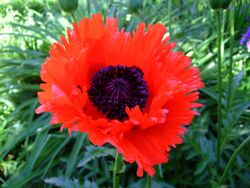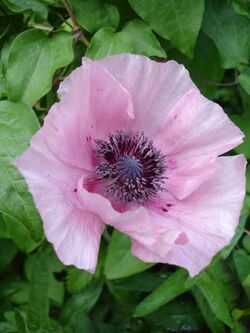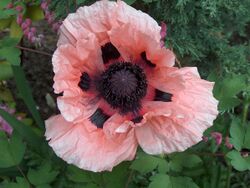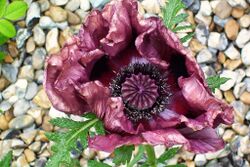Biology:Papaver orientale
| Oriental poppy | |
|---|---|
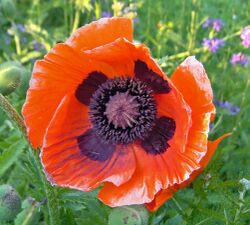
| |
| Scientific classification | |
| Kingdom: | Plantae |
| Clade: | Tracheophytes |
| Clade: | Angiosperms |
| Clade: | Eudicots |
| Order: | Ranunculales |
| Family: | Papaveraceae |
| Genus: | Papaver |
| Species: | P. orientale
|
| Binomial name | |
| Papaver orientale | |
Papaver orientale, the Oriental poppy,[2] is a perennial flowering plant[3] native to the Caucasus, northeastern Turkey, and northern Iran.[4]
Oriental poppies grow a mound of leaves that are hairy and finely dissected in spring. They gather energy and bloom in mid-summer. After flowering the foliage dies away entirely, a property that allows their survival in the summer drought of Central Asia. Gardeners can place late-developing plants nearby to fill the developing gap.
Cultivation
Papaver orientale usually thrives in soil pH 6.5 to 7.5 and in full sun or part shade. Seeds are sown after the potential of frost has passed, the average temperature is approximately 21 °C and when soil has thoroughly warmed. The seeds are sown at a depth of about one centimeter, or less as light may stimulate germination. Oriental Poppies do not handle transplanting or over-watering well. Germination period is 10–20 days. Mulch can be used to protect the plant over the winter and deadheading will produce a second flower.[citation needed]
Cultivars
Cultivars (those marked agm have gained the Royal Horticultural Society's Award of Garden Merit):-[5]
|
|
See also
Oriental Poppies, 1927 painting by Georgia O'Keeffe
References
- ↑ Linne, Carl von (1753). Species Plantarum. 1. Holmiae :Impensis Laurentii Salvii. pp. 508. https://www.biodiversitylibrary.org/page/358527.
- ↑ (xls) BSBI List 2007, Botanical Society of Britain and Ireland, https://bsbi.org/download/3542/, retrieved 2014-10-17
- ↑ USDA Profile
- ↑ {{citation | mode = cs1 | title = Papaver orientale | work = Germplasm Resources Information Network (GRIN) | url = | publisher = [[Organization:Agricultural Research ServAgricultural Research Service (ARS), United States Department of Agriculture (USDA) | access-date = 10 January 2018 }}
- ↑ "AGM Plants - Ornamental". Royal Horticultural Society. July 2017. p. 71. https://www.rhs.org.uk/plants/pdfs/agm-lists/agm-ornamentals.pdf. Retrieved 17 April 2018.
- ↑ "RHS Plant Selector - Papaver orientale 'Ajaga'". https://www.rhs.org.uk/Plants/366038/Papaver-(Oriental-Group)-Aglaja/Details.
- ↑ "RHS Plant Selector - Papaver orientale 'Black and White'". https://www.rhs.org.uk/Plants/366115/Papaver-(Oriental-Group)-Black-and-White/Details.
- ↑ "RHS Plant Selector - Papaver orientale 'Cedric Morris'". https://www.rhs.org.uk/Plants/366143/Papaver-(Oriental-Group)-Cedric-Morris/Details.
- ↑ "RHS Plant Selector - Papaver orientale 'Effendi'". https://www.rhs.org.uk/Plants/366202/Papaver-(Oriental-Group)-Effendi/Details.
- ↑ "RHS Plant Selector - Papaver orientale 'John III'". https://www.rhs.org.uk/Plants/366263/Papaver-(Oriental-Group)-John-III/Details.
- ↑ "RHS Plant Selector - Papaver orientale 'Karine'". https://www.rhs.org.uk/Plants/366267/Papaver-(Oriental-Group)-Karine/Details.
- ↑ "RHS Plant Selector - Papaver orientale 'Khedive'". https://www.rhs.org.uk/Plants/366268/Papaver-(Oriental-Group)-Khedive-(d)/Details.
- ↑ "RHS Plant Selector - Papaver orientale 'Leuchtfeuer'". https://www.rhs.org.uk/Plants/366293/Papaver-(Oriental-Group)-Leuchtfeuer/Details.
- ↑ "RHS Plant Selector - Papaver orientale 'Lighthouse'". https://www.rhs.org.uk/Plants/366295/Papaver-(Oriental-Group)-Lighthouse/Details.
Sources
External links
Wikidata ☰ Q149279 entry
 |
